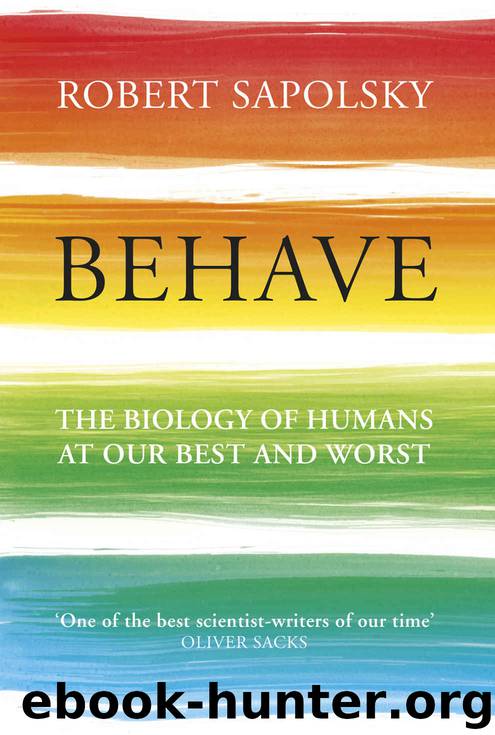Behave: The Biology of Humans at Our Best and Worst by Robert M Sapolsky

Author:Robert M Sapolsky [Sapolsky, Robert M]
Language: eng
Format: azw3
ISBN: 9781448129782
Publisher: Random House
Published: 2017-05-25T04:00:00+00:00
FOOLS RUSH IN: APPLYING THE FINDINGS OF THE SCIENCE OF MORALITY
HOW CAN THE insights we already have in hand be used to foster the best of our behaviors and lessen the worst?
Which Dead White Male Was Right?
Let’s start with a question that has kept folks busy for millennia, namely, what is the optimal moral philosophy?
People pondering this question have grouped the different approaches into three broad categories. Say there’s money sitting there, and it’s not yours but no one is looking; why not grab it?
Virtue ethics, with its emphasis on the actor, would answer: because you are a better person than that, because you’ll have to live with yourself afterward, etc.
Deontology, with its emphasis on the act: because it’s not okay to steal.
Consequentialism, with its emphasis on the outcome: what if everyone started acting that way, think about the impact on the person whose money you’ve stolen, etc.
Virtue ethics has generally taken a backseat to the other two in recent years, having acquired a quaint veneer of antiquarian fretting over how an improper act tarnishes one’s soul. As we’ll see, I think that virtue ethics returns through the back door with considerable relevance.
By focusing on deontology versus consequentialism, we are back on the familiar ground of whether ends justify means. For deontologists the answer is “No, people can never be pawns.” For the consequentialist the answer is “Yes, for the right outcome.” Consequentialism comes in a number of stripes, taken seriously to varying degrees, depending on its features—for example, yes, the end justifies the means if the end is to maximize my pleasure (hedonism), to maximize overall levels of wealth,fn11 to strengthen the powers that be (state consequentialism). For most, though, consequentialism is about classical utilitarianism—it is okay to use people as a means to the end of maximizing overall levels of happiness.
When deontologism and consequentialism contemplate trolleys, the former is about moral intuitions rooted in the vmPFC, amygdala, and insula, while the latter is the domain of the dlPFC and moral reasoning. Why is it that our automatic, intuitive moral judgments tend to be nonutilitarian? Because, as Greene states in his book, “Our moral brains evolved to help us spread our genes, not to maximize our collective happiness.”
The trolley studies show people’s moral heterogeneity. In them approximately 30 percent of subjects were consistently deontologists, unwilling to either pull a lever or push a person, even at the cost of those five lives. Another 30 percent were always utilitarian, willing to pull or push. And for everyone else, moral philosophies were context dependent. The fact that a plurality of people fall into this category prompts Greene’s “dual process” model, stating that we are usually a mixture of valuing means and ends. What’s your moral philosophy? If harm to the person who is the means is unintentional or if the intentionality is really convoluted and indirect, I’m a utilitarian consequentialist, and if the intentionality is right in front of my nose, I’m a deontologist.
The different trolley scenarios reveal what circumstances push us toward intuitive deontology, which toward utilitarian reasoning.
Download
This site does not store any files on its server. We only index and link to content provided by other sites. Please contact the content providers to delete copyright contents if any and email us, we'll remove relevant links or contents immediately.
Sapiens: A Brief History of Humankind by Yuval Noah Harari(13041)
The Tidewater Tales by John Barth(12026)
Do No Harm Stories of Life, Death and Brain Surgery by Henry Marsh(6333)
Mastermind: How to Think Like Sherlock Holmes by Maria Konnikova(6227)
The Thirst by Nesbo Jo(5779)
Why We Sleep: Unlocking the Power of Sleep and Dreams by Matthew Walker(5637)
Sapiens by Yuval Noah Harari(4531)
Life 3.0: Being Human in the Age of Artificial Intelligence by Tegmark Max(4496)
The Longevity Diet by Valter Longo(4444)
The Rules Do Not Apply by Ariel Levy(3898)
The Immortal Life of Henrietta Lacks by Rebecca Skloot(3821)
The Body: A Guide for Occupants by Bill Bryson(3791)
Why We Sleep by Matthew Walker(3768)
Animal Frequency by Melissa Alvarez(3750)
Yoga Anatomy by Kaminoff Leslie(3697)
Barron's AP Biology by Goldberg M.S. Deborah T(3629)
The Hacking of the American Mind by Robert H. Lustig(3576)
All Creatures Great and Small by James Herriot(3508)
Yoga Anatomy by Leslie Kaminoff & Amy Matthews(3392)
